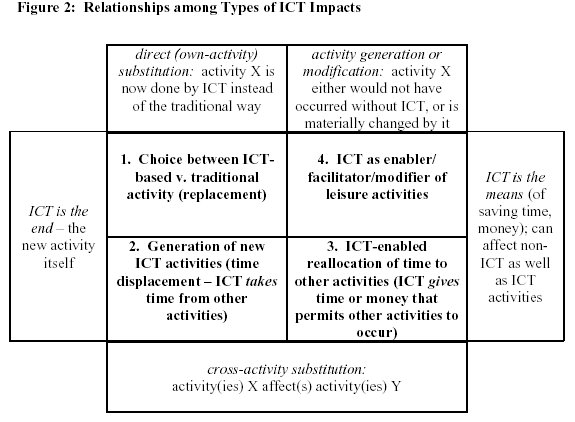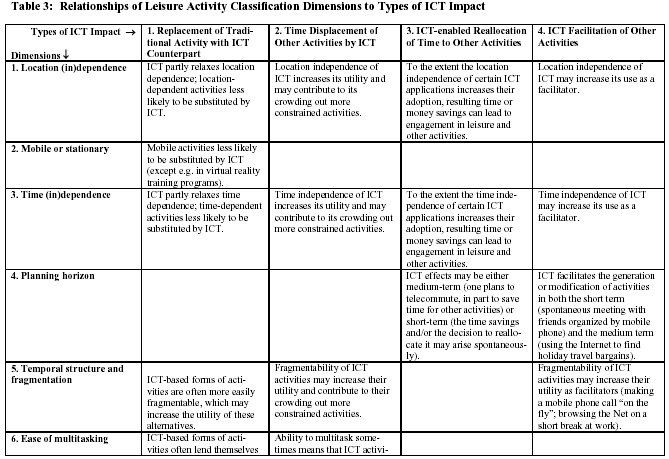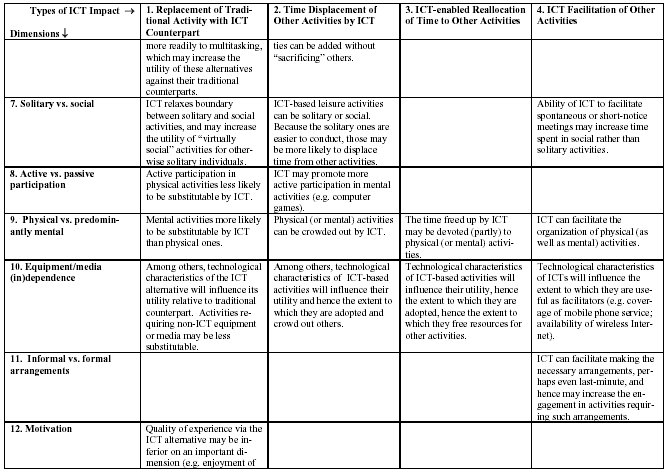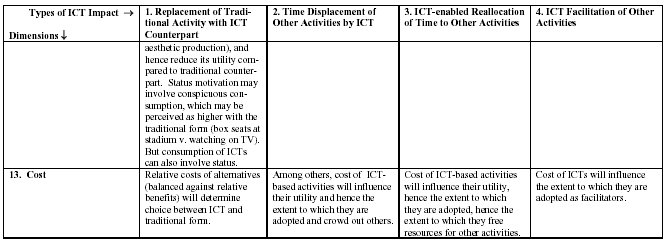|
home activities and/or a greater variety of activities, than before.
The impact on travel is likely to be modification in some cases (e.g.
en-route diversions in response to a mobile phone call), outright
generation in others (organizing a social activity on the fly that
would not have occurred without the mobile phone), and (less often,
we believe) reduction in others (as when a phone call en route prevents
one from driving around lost).
As discussed further in Section 3.2 below, ICTs have a number of characteristics
that support
their increasing popularity as facilitators: location independence,
time independence, fragmentability, and multitasking ability. Currently,
technological factors and cost are still barriers in many circumstances,
but these barriers are rapidly being eroded with further technological
progress.
3.1.5 Similarities and Differences among the Four Types of Impacts
Figure 2 groups the four types of impacts in such a way as to illustrate
similarities and differences among them. We see, for example, that
categories 1 and 2 have in common that ICT is in some sense the “end”
– the basis of conducting the new activity itself. In category
1 the ICT leisure activity directly replaces its traditional counterpart,
whereas in category 2 the ICT
activity more indirectly displaces other activities through a reordering
of one’s time allocation
priorities. In categories 3 and 4, ICT is the “means” –
the instrument by which other activities of interest are affected,
rather than the affected activity itself. Categories 2 and 3 both
involve a reallocation of one’s time budget, with cross-activity
effects (something about activity(ies) X affect(s) activity(ies) Y).
In the case of category 2, ICT (activity X) takes time from other
activities (Y), whereas in category 3, ICT (X) gives time (or money)
that can be spent on other
activities (Y), whether non-ICT or ICT, leisure or other. Category
4 is a case of activity
generation or modification: activity X either would not have occurred
at all without ICT (which is viewed in this context as being mainly
the ancillary instrument rather than a separate activity 18),
or is materially changed by it19. Category 1 is a case
of direct or own-activity substitution, in contrast to the cross-activity
substitution effects of Categories 2 and 3.
To fully understand the leisure-related impacts of ICT, it is important
to consider all of these
types of effects. While it may be tempting to focus on modeling the
choice between ICT- and
location-based forms of an activity (category 1) because it is relatively
straightforward to do so, for example, that may not constitute the
largest impact of ICT on leisure travel. In truth, we do not know
at this point the magnitudes or even the rank-ordering of the travel
impacts of these four types of effects. There is fertile ground for
further research.

3.2 ICT and Relevant Dimensions of Leisure
The complexity of leisure activities is reflected in the diversity
of dimensions under which
leisure, including its ICT-based versions, can be classified and affect
choice. A comprehensive classification extends beyond the scope of
the current report, but the list of factors having ICT relevance and
those of interest from a spatial behavior perspective is described
below. Perhaps the most important dimensions are time and space, but
many others warrant the attention of researchers as well.
For convenience, in discussing the various interactions between ICT
and activities, we refer to changes within the leisure activities
category (substitution or complementarity) as intra-category interactions
while changes between leisure and other categories (work and maintenance)
are called inter-category interactions.
From the diverse list of dimensions available to classify leisure
activities, the following discussion focuses on 13 that seem to us
to be the most ICT “sensitive” (Doherty, 2003 uses some
of these same dimensions to characterize any type of activity). As
a way of organizing the discussion, these dimensions are grouped into
five types: location, time, social context, traits intrinsic to the
activity, and the benefit/cost tradeoff. Accompanying the description
of the 13 dimensions, Table 3 summarizes the relationships between
the four types of ICT interactions introduced in Section 3.1, and
each of the dimensions. Although some blank cells of Table 3 could
be filled in, those relationships seem less likely and/or less important
than the ones that are included.
Continua >>>>>
|



